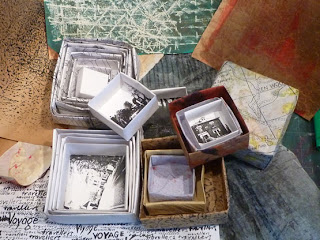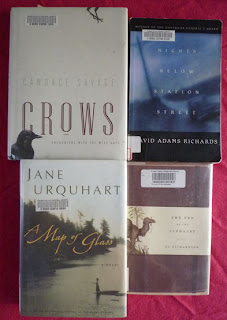Back in 1995, when Tony and I were travelling back and forth from Stroud Green Road to Wrentham Avenue in his rattly, beloved Suzuki, I started a project (in some textiles course or other) documenting the journey. First were the photographs, and some "mood drawings" and prints -
 The bench beside the road, several turns beyond Hampstead Heath, is no longer there. "Spooky house" has been renovated and has, in effect, disappeared into the row of other "nice" houses on the street. The Suzuki was sold (and its replacement has also been replaced); the former church, latterly community centre, on the corner has become, after much aggro about the new tower, a mosque. Changes, changes...
The bench beside the road, several turns beyond Hampstead Heath, is no longer there. "Spooky house" has been renovated and has, in effect, disappeared into the row of other "nice" houses on the street. The Suzuki was sold (and its replacement has also been replaced); the former church, latterly community centre, on the corner has become, after much aggro about the new tower, a mosque. Changes, changes...Next stage - mapping, a travelogue including the points of interest. Monoprints (on envelopes that had been sent to us) incorporating map symbols -
 More textured papers, intended for I no longer remember what; and the almost-final product, the boxes, made of photocopied maps at various enlargements, with a photocopy (this is the pre-digital era!) of the relevant photograph in the bottom. The boxes go inside each other, and I also made other boxes of handmade paper and various painted papers (and maps) soaked in melted wax -
More textured papers, intended for I no longer remember what; and the almost-final product, the boxes, made of photocopied maps at various enlargements, with a photocopy (this is the pre-digital era!) of the relevant photograph in the bottom. The boxes go inside each other, and I also made other boxes of handmade paper and various painted papers (and maps) soaked in melted wax -
 To get this into the realm of stitch, there was an attempt to make a layered, textured "thing" -
To get this into the realm of stitch, there was an attempt to make a layered, textured "thing" -
 The moths found the woolly bits and added another layer of history.
The moths found the woolly bits and added another layer of history.
 More textured papers, intended for I no longer remember what; and the almost-final product, the boxes, made of photocopied maps at various enlargements, with a photocopy (this is the pre-digital era!) of the relevant photograph in the bottom. The boxes go inside each other, and I also made other boxes of handmade paper and various painted papers (and maps) soaked in melted wax -
More textured papers, intended for I no longer remember what; and the almost-final product, the boxes, made of photocopied maps at various enlargements, with a photocopy (this is the pre-digital era!) of the relevant photograph in the bottom. The boxes go inside each other, and I also made other boxes of handmade paper and various painted papers (and maps) soaked in melted wax - To get this into the realm of stitch, there was an attempt to make a layered, textured "thing" -
To get this into the realm of stitch, there was an attempt to make a layered, textured "thing" - The moths found the woolly bits and added another layer of history.
The moths found the woolly bits and added another layer of history.It's tempting to resurrect this project for my current course, and I'm curious as to how different-yet-basically-the-same it would be....














































